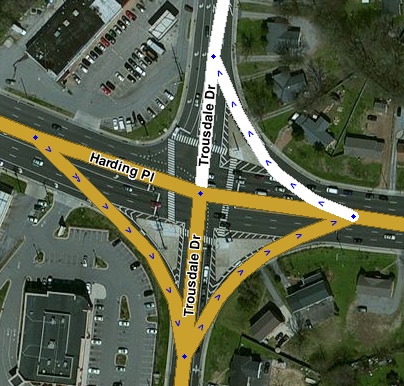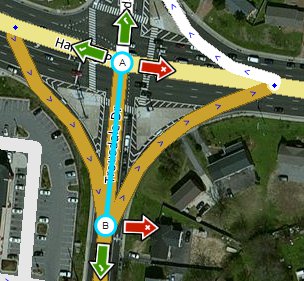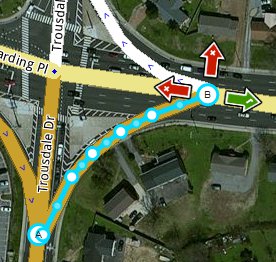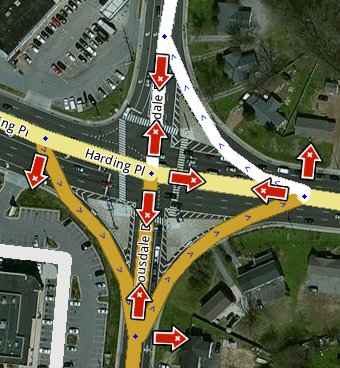When traffic moves between two roads that are at the same grade, these connecting segments are not technically ramps to Waze (unless it falls into one of the Exceptions listed below). How to handle these connectors depends on the exact situation.
Applications
As commonly applied in Waze, at-grade connectors serve the following purposes in decreasing order of priority:
- Represent a physically separate, distinct road corridor that connects two larger roads at the same elevation. To qualify for this purpose, a connector must be sufficiently isolated from the larger roads that a typical driver would be surprised not to see it explicitly depicted on the client display. This is At-Grade Connectors' primary function and they are always called for in this situation.
- Prevent incorrect "snapping" of drivers to nearby roads. Where frontage roads parallel very wide and intersecting highways for an extended distance, At-Grade Connectors at the intersections may discourage Waze from snapping drivers to the frontage roads. This is an uncommon situation.

- Prevent "missing road" automated Map Problem errors. Tracks that appear to Waze to be "cutting the corner" may cause Waze's automated missing-road detection algorithms to flag a Map Problem. Adding At-Grade Connectors to prevent these is usually encouraged but in some cases, such as large bowtie junctions, may result in an excessively cluttered and confused display.
- Advance timing of spoken turn alerts. At-Grade Connector cause turn alerts to be issued earlier. In complex situations, such as highways of three or more lanes in one direction and/or uncommonly early "commit points" due to extended road striping or physical barriers for the turn, advancing the alert may help prevent missed turns. In most cases, however, the default turn timing is adequate. In particular, any consideration of advancing alerts should focus on timing of penultimate, not final, turn alerts. Final turn alerts at complex intersections almost always come too late for drivers who hadn't been paying attention to the previous alerts and the community generally does not modify the maps to accommodate those situations.
Should the connector be mapped?
First and foremost, the need to have the connector mapped needs to be established. As the driver approaches an intersection, Waze has usually given at least one warning that a turn is imminent, and we can assume that the driver is already looking for turn lanes. For most intersections, that is enough to guide the driver into the proper lane and to turn at the proper time; in other words, it is enough that the two roads intersect without separately mapped turning lanes.
There are only a few situations in which connectors are called for in an intersection:
- When the turn lane physically separates from the main road well in advance of the intersection
- When the turn lane is far enough from the point of intersection on the map (due to the size of the intersection or the angle at which the roads meet) that the driver might overshoot while waiting for a delayed "turn" audible, or that the Waze client might become confused and disrupt navigation
- When the area is "busy" enough that the driver may not get any advance warning that a turn is coming up--in which case a connector lets you notify the driver a little earlier
- When there are user complaints (Update Requests) that the audible was too late, or that the map should have shown a connector
When in doubt, leave it out. Each connector complicates the map and adds to your workload when the time comes to check connectivity, direction, name, etc.
Road type
Although sometimes referred to as ramps, to Waze these are not ramps. Ramps in Waze should only be used for situations where two roadways have a grade separated intersection or if the situation matches one of the Exceptions listed below.
The connector segment's type should be set based on the lowest of the types of roads it connects.
- Ex: Street to Minor Highway should be Street type.
- Ex: Minor Highway to Primary Street should be Primary Street type.
- Ex: Primary Street to Primary Street should be Primary Street type.
Example:
Also note how the top-left quadrant of the intersection does not have a connector mapped because it does not meet the requirement of being significantly separated from the main intersection.
Road name
In most cases, leaving the segment unnamed will be sufficient. Navigation instructions will simply use the name of the segment to which the connector segment connects.
If there are specific signs at the intersection which are confusing or contrary to the destination road segment name, then a name can be applied to the connector.
Geometry
The Junction Style Guide provides significant information on how to best set the geometry of the connector to get the best routing and text-to-speech result. Be sure to review that article when updating or creating these connectors.
Turn restrictions
Connectors, if simply added to the map and all turns allowed, would cause significant routing challenges, especially between two 2-way roads. Split roadways have their own challenges, but turn restrictions, due to the 1-way nature of the main segments, are simpler.
In the US, a simple right-turn connector between two 2-way streets, requires that the right turn be restricted at both the primary intersection, and at the connector itself so Waze will not be allowed to tell the driver to turn left across the road to get onto the connector.
AND, at the end of the connector, the left turn must be restricted:
If you enable the "show all restricted connectivity arrows" function in the editor at this intersection, you can see there are many restricted turns. This is sometimes a target for someone looking to remove all restricted turns by abusing the use of the 'w' or Allow All turns function:
Exceptions
| This revision of a section is currently undergoing modifications. The information presented should be considered a draft, not yet ready for use. Content is being prepared by one or more users. Do not make any changes before you post a message in this forum. |
Median U turn intersection (MUTI)

The median crossing segments in a median U turn (aka "Michigan left") intersection should be set to the Ramp type.
Restricted crossing U turn (RCUT) intersection

The median crossing segments in a restricted crossing U turn (aka "J turn" or "Superstreet") intersection should be set to the Ramp type.
Displaced left turn (DLT) intersection

The crossover left turn lanes and the resultant elongated right turn lanes in a displaced left turn (or "continuous flow") intersection should be set to the Ramp type.
Jughandle

Jughandle segments should be set to the Ramp type.
Signed, numbered exit

Example: Garden State Parkway Exit 10 in Cape May Court House, New Jersey, USA. The Garden State Parkway is mostly a freeway class toll-road that runs north/south through New Jersey. As the Parkway approaches its southern terminus, the number of lanes reduce and exits become a mix of grade separated ramps and at-grade intersections. In order to receive an instruction for Exit Right rather than Keep Right or Turn Right, this connector needs to be a ramp.

|

|
Going north, the right turn lane is signed as Exit 10B and the left turn lane is signed as Exit 10A (and reversed going south). |



